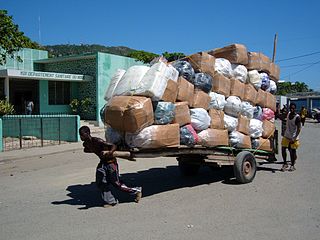
A cart or dray is a vehicle designed for transport, using two wheels and normally pulled by one or a pair of draught animals. A handcart is pulled or pushed by one or more people.

Georgios Ioannou Rallis, anglicised to George Rallis, was a Greek conservative politician and the 2nd Prime Minister of Greece from 1980 to 1981.
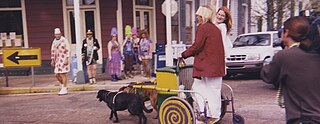
Carting is a dog sport or activity in which a dog pulls a dogcart filled with supplies, such as farm goods, camping equipment, groceries or firewood, but sometimes pulling people. Carting as a sport is also known as dryland mushing and is practiced all around the world, often to keep winter sled dogs in competition form during the off-season.

A sulky is a lightweight cart with two wheels and a seat for the driver, generally pulled by horses or dogs. With horses, a sulky is used for harness racing. The term is also used for an arch-mounted cart on wheels or crawler tracks, used in logging, or other types of vehicle having wheels and usually a seat for the driver, such as a plough, lister or cultivator.

A horse-drawn vehicle is a mechanized piece of equipment pulled by one horse or by a team of horses. These vehicles typically had two or four wheels and were used to carry passengers and/or a load. They were once common worldwide, but they have mostly been replaced by automobiles and other forms of self-propelled transport.

A sprung cart was a light, one-horse, two-wheeled vehicle with road springs, for the carriage of passengers on informal occasions. Its name varied according to the body mounted on it.
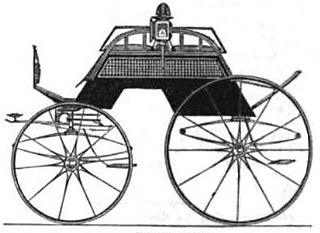
A dogcart is a light horse-drawn vehicle, originally designed for sporting shooters, with a box behind the driver's seat to contain one or more retriever dogs. The dog box could be converted to a second seat. Later variants included :
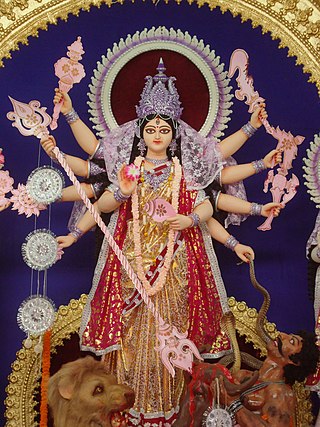
Kolkata, India, is largely inhabited by the ethnic community of the native Bengalis respectively. According to a report by the Indian Statistical Institute owned by the Government of India, the Kolkata city had a population of 4.5 million as of 2011 out of which the population of native Bengalis in Kolkata is almost 62% which comprised the majority of the city's population, whereas ethnic groups like Marwaris, Biharis and Urdu-speaking Muslims together forming 36% of the population which comes under the category of large minorities. Other Various micro-minority communities of Kolkata include as far as concerned follows -: Sindhi people, Pathan people, Marathi people, Odia people, Gujarati people, Kashmiri people, Punjabi people, Nepalis, Telugus, Tamil, Anglo-Indian, Iraqis, Jewish, Armenian, Tibetan, Greek, Parsi, Chinese, and Iraqi people etc.

Ioannis Rallis was the third and last collaborationist prime minister of Greece during the Axis occupation of Greece during World War II, holding office from 7 April 1943 to 12 October 1944, succeeding Konstantinos Logothetopoulos in the Nazi-controlled Greek puppet government in Athens.
Rallis, Ralli or Ralles is the name of an old Greek Phanariote family, whose members played important political role in the history of modern Greece, Danubian Principalities and later in the United Kingdom. One branch of the family, living in Great Britain, gained the title of Baronet in 1912 and thus became the Ralli baronets. They claim descent from the Frankish-Byzantine noble Raoul/Ralles family.

Dimitrios Rallis was a Greek politician.
The Ralli Baronetcy, of Park Street in the City of Westminster, is a title in the Baronetage of the United Kingdom. It was created on 8 February 1912 for Lucas Ralli, head of the firm of Ralli Brothers, who were financiers, shippers, cotton and grain merchants. The Ralli Family are of Greek origin, and are ultimately descended from the Frankish-Byzantine Raoul/Ralles Family. Originally from the Greek island of Chios, due to the Chios massacre the Ralli family was forced to emigrate to the United Kingdom, where they founded the eponymous firm.
The five Ralli brothers, Zannis a.k.a. John (1785–1859), Augustus (1792–1878), Pandia a.k.a. Zeus (1793–1865), Toumazis (1799–1858), and Eustratios (1800–84), founded Ralli Brothers, perhaps the most successful expatriate Greek merchant business of the Victorian era.
Horse harness is a device that connects a horse to a vehicle or another type of load.
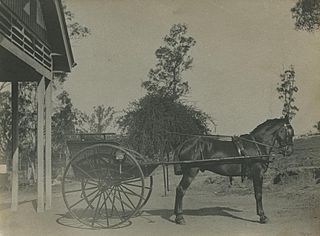
A trap, pony trap or horse trap is a light, often sporty, two-wheeled or sometimes four-wheeled horse- or pony-drawn carriage, usually accommodating two to four persons in various seating arrangements, such as face-to-face or back-to-back. In the eighteenth century, the first carriage to be called a trap was a gig with a hinged trap door, under which was a place to carry a dog. In late nineteenth century USA, four-wheeled dog carts with convertible seats also started to become known as traps.

A hot dog cart is a specialized mobile food stand for preparing and selling street food, specifically hot dogs, to passersby. In some jurisdictions, a cart operator must meet stringent health regulations designed to protect the public. Hot dog carts are quick and easy food services, supplying millions of people with food every day. In 2015 the U.S. Hot Dog Council estimated that 15% of the approximately 10 billion hot dogs consumed by Americans in 2014 were purchased from a mobile hot dog vendor cart. Hot dog carts are very common in New York City, and most of the hot dogs purveyed by hot dog carts in New York City are sourced from Sabrett.
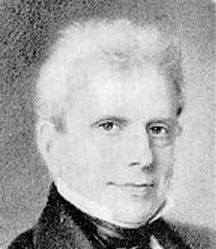
Georgios Sinas was an Austrian-Greek entrepreneur and banker. He became a national benefactor of Greece and was the father of another Greek national benefactor, Simon Sinas. He was also the founder of the National Observatory of Athens.

The Chian diaspora was the dispersal of most of the remaining population of the Aegean island of Chios, after the massacre of 1822. It is one part of the larger Greek diaspora.
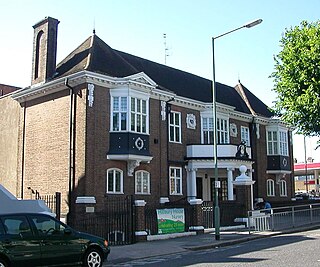
Ralli Hall is a community centre, events venue, theatre stage, business hub and impressive main hall in Hove, part of the English coastal city of Brighton and Hove. Built in 1913 as a memorial to Stephen Ralli, a member of a wealthy Greek family who had donated money to many causes throughout Brighton and Hove, it was used for about 60 years as a church hall linked to Hove's parish church. The Brighton & Hove Jewish community subsequently bought it, and in 1976 it came back into use as a community and social centre for Jewish and other groups. The Wrenaissance-style brick structure occupies a prominent corner site in a conservation area and provides a visual contrast to the older villas around it. English Heritage has listed the building at Grade II for its architectural and historical importance.















